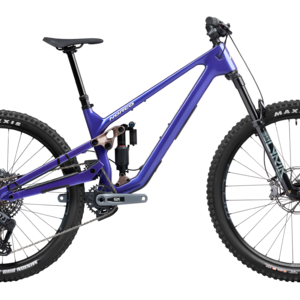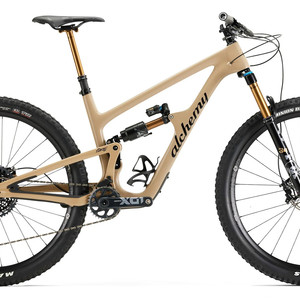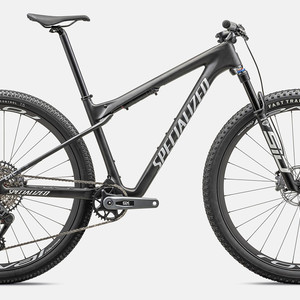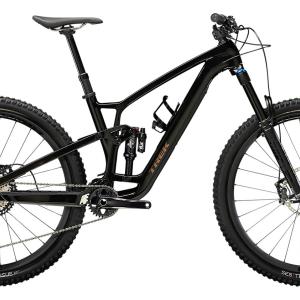2016 Santa Cruz Hightower Carbon CC X01 29
(discontinued)
| Where To Buy | |||
|---|---|---|---|
Free shipping on orders over $50 (continental U.S. only).
International shipping available. Some exclusions apply. |
|||
Free U.S. shipping on orders over $45.
International shipping available. Some exclusions apply. |
|||
Free shipping on orders over $50 (continental U.S. only).
International shipping available. Some exclusions apply. |
|||
Feature by AJ Barlas // Photos by Gary Perkin, Sven Martin and AJ Barlas
Back in 2012, when Santa Cruz Bicycles launched the Tallboy LT - the longer-legged version of their well-received Tallboy - they broke the mould. At a time when wagon wheelers were generally considered to be average performing XC bikes that lacked any “fun” characteristics, the Tallboy LT changed many opinions. That was more than three years ago now, and the California-based company has been hard at work on the new Hightower, a replacement for the LT. We were excited to see how Santa Cruz was going to improve on things, especially given the evolution of their bikes over the last few years. Throw in an expedition through Southern Chile as part of the Rally Aysen Patagonia and we had the perfect recipe to check out the new mid-travel 29er...

2016 Santa Cruz Hightower Highlights
- Carbon CC or C frame
- Compatible with both 29" and 27.5+ wheels
- 29" front/rear travel: 140 / 135mm
- 27.5+ front/rear travel: 150 / 135mm
- Adjustable Toggle Chip for geometry/wheel changes
- Updated 148mm rear / 110mm front hub spacing
- Internal cable tunnels
- 73mm threaded bottom bracket
- ISCG05 mounts
- Molded downtube and chainstay protectors
- 200x51mm RockShox shock with LC LR tune, high volume eyelet, and four volume spacers
- Medium / Large / XL sizes (no small)
- Sriracha Red / Matte Carbon & Minty colors
- Comes in three 29" builds, three 27.5+ builds, or as a frame/shock package
- Weight: 29" CC X01 - 12.7kg (28.1lb) // 27.5+ CC X01 - 12.7kg (28.0lb) // Frame Only - 2.7kg (5.9lb), size Large
The media circus arrived in Coyhaique, Chile, with little more than rumors surrounding why Santa Cruz had brought us all this. Generally the group was of the impression that it would be a new Tallboy LT, but it was still speculation. When we first sat down with the Santa Cruz team consisting of marketing dudes Will Ockelton and Don Palermini, Product Manager Josh Kissner, and the engineer behind the current flow of bikes, Nick Anderson, we were treated to an impressive-looking bike with a new name: the Hightower.
At first glance the Hightower draws a similar appearance to the Nomad, with twin uprights between the chain and seatstays, plus a similar shock orientation. Nick Anderson noted this design was used in order to make the bike adjustable and maintain a short chainstay, which required removing the front derailleur mount. Once the front derailleur was removed, the ability to run the twin upright swingarm was possible and doing so, also granted the rear of the bike some added stiffness.
The Hightower, like other Santa Cruz bikes, features a 73mm threaded bottom bracket (thank you!), ISCG05 tabs for those wishing to run a guide for extra chain security, and the updated VPP suspension link design of their other current models. Also, like many of their latest rides, the Hightower comes with a 150mm travel Rockshox Reverb dropper, so you can get the seat well out of the way when the going gets rowdy.

The team went on to introduce what immediately looked to be a fun-loving bike, and the initial introduction solidified those impressions. Although the Tallboy LT had the same 135mm of travel as the Hightower, it was quickly addressed that this is a different bike that takes on a number of years worth of evolution within the Santa Cruz camp. The bike is aimed to appease those that are after a mid-travel 29er and the benefits of the larger wheel, but still exhibits a nimble attitude similar to that of the smaller 27.5” sleds in the Santa Cruz fleet. The big surprise being that not only is this a 29er, it fairly easily converts to a plus bike, for those looking to try out the new bastard-child wheel size.
This adjustability is largely possible thanks to the industry shift to the wider "Boost” axle spacing. The benefits of the extra width is especially present where 29" wheels are involved, and allows the hub flanges to be pushed outbound a total of 6mm in the rear, and a total of 10mm in the front. This extra width creates a wider spoke bracing angle and in turn provides a stiffer wheel, in effect improving the ride quality and responsiveness of wagon wheels without the need to throw down the big bucks for carbon hoops. At the same time, the added width makes it possible to have plenty of clearance for a plus sized wheel, and Santa Cruz have gone the extra mile to optimize the performance of both wheel sizes within one frame.

Santa Cruz noted that a 27.5+ and 29" wheel can generally vary in size up to 18mm, with the 27.5+ being the slightly smaller of the two. This translates to roughly 9mm difference in bottom bracket height between the two, plus some extra tire squish. While low bikes can be fun, Santa Cruz developed a flip chip positioned at the rear shock eyelet of the bike to help pick up the bottom bracket slightly when used with 27.5+ wheels. It can be used in the high setting with 29" wheels, pushing the bottom bracket height up to ~340mm and the head angle to 67.25º, but Santa Cruz feel the bike performs best in the low setting with this wheel size.

You'll also have to change the fork when switching over to the stubbier wheels. Spec’d on the 29" Hightower is a 140mm Pike, but when switching over to the plus size wheel it’s recommended that a 150mm fork be used. This can be done internally on the Pike with a relatively cheap part and a little elbow grease. Another option, and one that some of the Santa Cruz team have been doing, is to run the bike with the 150mm fork all the time. This results in the bike performing as expected when setup with the plus wheels, but gives it a slightly more aggressive stance when fitted with the 29" wheels which could be very appealing to some.

In either the 29 or 27.5+ configuration (shown above), the Hightower joins the party at the long, low and slack table, but does so without going to ridiculous extremes. The reach on a medium frame comes in at 420mm and the XL that we rode came in at 475mm. While talking size, we should also mention that the Hightower does not come in a small or extra small. Going that small created too many compromises, essentially making it a different bike to its larger framed counterparts. Shorter riders interested in a bike like this can look to the Bronson, which is the closest in terms of ride quality to the Hightower.
Similar to other recent Santa Cruz models, the seat tube lengths have been shortened slightly, allowing for more flexibility in sizing. The seat tube takes on a more aggressive static number of 74.3º, granting riders a stronger seated position and aiding with getting up over the relatively slack front end. With a bottom bracket height of 337mm (13.2") and drop of 33mm when rocking its 29" shoes, it certainly plays to the low statement as well. The relatively short 435mm (17.1") chainstays and solid 1165mm wheelbase (for a size medium) contribute to the nimble desires of the Hightower, but don’t lose out where stability is concerned.
Swapping out the 29" wheels with the 27.5+ variety obviously changes the numbers slightly. Once the flip chip has been set to the recommended “High” position and the fork set to 150mm, the head angle slackens slightly to 66.8º, the seat angle slackens a little to 74.1º, and the bottom bracket drops 2mm. With the change in the flip chip there is also a minor change to the leverage curve of the rear shock, but nothing discernible even to the most picky of suspension geeks. All of this adds up to what appears to be a pretty aggressive, adjustable bike.
Geometry

Interview With Santa Cruz
We sat down with Santa Cruz engineer, Nick Anderson, to chat about what inspired the Hightower, similarities to the Tallboy LT and Nomad, getting rid of the front derailleur, and alternative uses for the toggle chip. Listen in:
On The Trail - 29" Mode
Being that we were in Coyhaique, Chile, a place that is just developing as a mountain bike destination thanks to guys like Gabito, a small crew of young, ambitious local kids, and Mattias from Montenbaik, we were looking at riding blind down some very, very new trails (fresh loamers anyone?) and covering a lot of ground. We started the week off with the Hightower setup in its 29" configuration. After an initial setup with 30% rear sag and the recommended settings in the Pike Solo Air RCT3 fork plus four clicks of low-speed compression, we loaded up and excitedly set off to the trails.
It quickly became evident that the bike boosts confidence, and in some cases almost too much so, playing into our stupid, childish side far too well. The very first pitch we dropped into - a varying degree drop down some nasty #chooseyourownadventure scree slopes - saw us relying heavily on the bike to get us through a couple of “dear sweet baby Jesus” moments. The stability the bike exhibited and our comfort aboard it from the outset was verified time and time again as we rode blindly down the South American trails, completely oblivious to what was around the next corner and generally riding like idiots. Here it is in action:
Our favorite trails in Patagonia consisted of wide open sections through super dusty, dry dirt. Often these high-speed sections would end abruptly with an unexpected corner. Choosing a line through these corners was somewhat of a guessing game, with no idea where the apex was or the best line. Laying the Hightower on edge rarely resulted in it getting upset, and regardless of whether adjustments were required or line choice was poor, the bike would whip through the turns and charge onward.
In fact, it didn’t appear that anything short of planting the front wheel into something you shouldn’t would phase the Hightower. Shoot over a blind rise in the middle of a turn and the bike would drift sideways only to catch, stabilize and rally on into the next section. Come into a rocky part of the trail and the bike would skip across it all unscathed. Slide down dirt “powder” a couple of inches deep and again, no issue. So long as the rider took control and didn’t do anything wrong, the bike would come out the other end, usually with rider hooting and hollering in sheer joy.

Climbing the bike was comfortable, and although we flipped the dial on the occasional long road ascent (something we blame our jet-lagged legs on more so than the bike) it is remarkably quiet under pedaling forces. Get up out of the saddle, lay down the power, and the bike zips up to speed quite effortlessly. Likewise, we found that the grip was such that standing efforts up fairly loose inclines was also admirable, with little loss in traction, provided rider position was adequate.
We found the front end of the bike to get quite light in tight, steep uphill corners and on steep inclines, making it tricky to keep it on line. Shifting up the saddle we found we were able to keep it more planted. On our second day aboard the Hightower we attempted to run the stem 5mm lower to combat this, and while it helped a little, we found that it was now a little on the low side for our preference when descending. We settled on the original stack height (20mm of spacers beneath the stem due to the flat bar) and employed an aggressive position on the bike, shifting up the saddle when the climb warranted it.
With the 29" wheels the bike handles incredibly well. It’s apparent that the old days of straight-line motivated wagon wheelers are behind us, and the Hightower is another bike adding to the selection of incredibly fun, nimble, and very capable big wheel sleds. The shorter stays and stout construction of the Hightower create a lively ride, while the 135mm of VPP suspension tracks remarkably well and feels bottomless. We used all of the travel on multiple occasions but were unaware of it at the time. High-speed chatter is muted well and did little to upset the bike. Small bump sensitivity is good, and loose, high-speed corners were no problem. The geometry is comfortable and results in a bike that feels at home once the initial cockpit adjustments have been dialed in, leaving it up to the rider to get going and see how far they can push it.

On The Trail - 27.5+ Mode
With the bike in the 27.5+ configuration it sits a few millimeters lower, and strangely it felt longer, despite the numbers not reflecting this. This isn’t our first time aboard a plus wheeled bike, and to be honest, this tester is still a little confused by it all. In certain situations, a good number of which were encountered while aboard the Hightower in Patagonia, plus size is great, but generally speaking we prefer the more defined feeling of a regular wheeled mountain bike.
Riding like idiots through fields and wooded environments littered with debris was a treat with the 27.5+ wheel. The larger footprint provides bucket loads of confidence in loose bits and rarely gets shook off line. Over loose terrain and through flat corners, laying the bike on its side and holding on with a death-grip was easier to stomach, with the big tires holding gob loads of traction. We did find that on proper narrow singletrack it was easier to get pulled up the bank to the high side of the trail, as the wider footprint would catch on earlier than we were ready and scoot us up the bench cut. We battled with this numerous times during descents on otherwise amazing bench-cut sections of singletrack.

Climbing in Patagonia often consisted of loose, dusty conditions that regularly resulted in the 29" wheel requiring more effort to keep momentum due to a loss of traction. This was far less of an issue on the 27.5+ Hightower, and we felt this configuration worked quite well in this scenario as we motored by riders on regular 29" wheels. The only downside was the lower bottom bracket height, which is even lower when you consider the tires sagging. This created clearance issues for us on numerous occasions, though it's something you could grow accustomed to with more time. Fitting a set of 170mm cranks would also help alleviate the problem.
Despite all of this traction, the lack of a defined side-knob or edge to the tire is something we miss on plus sized wheels. Cornering can be a little vague, and generally we find ourselves putting faith in the extra traction purely because of the amount of surface area/rubber rolling on the ground beneath us. There is no “aha” moment where you feel the edge of the tire bite into the terrain and begin to churn up the dirt. To be honest, for us, that is one of the best feelings when riding a mountain bike. Yet we digress, as this is not a knock against how the Hightower rides with the plus wheels fitted, and more of a general observation for all plus bikes. The Hightower handles very well in its plus size configuration with many of the attributes of the 29" wheel being transferred over. This is the most nimble of plus bikes we've ridden, which is good given the plus sized wheel's tendency to dampen a bike's agility and trail feel.
What's The Bottom Line?
Our time aboard the Hightower left us wanting more! The bike in either wheel size configuration is a treat to ride. It's capable of getting rowdy and aiding riders through rough point-and-shoot situations, while exhibiting a wildly enjoyable, nimble side when the trail tones down. Be it twisting, tight sections of singletrack, or wide open “full gas” straightaways, the bike takes it all in its stride and will get you back up to the top with relative ease. The simple fact that we were immediately comfortable speaks loads to the bike's naturally inspiring demeanor.

Build Kits, Pricing and Availability
We spent the majority of our time aboard the mid-range $6,499 CC X01 29 build and found little that we would change, save a few parts for personal preference. There's a 27.5+ version of the CC X01, too. Want the best parts? Step up to the CC XX1 build in 29" or 27.5+ at $7,799 with an optional 29" $2,000 ENVE wheelset upgrade. There are also C AM 29" and 27.5+ models for $4,599, which are more than capable of a good time. A CC frame + RockShox Monarch RT3 shock combo is available for $2,899 for those looking to create a custom build.

The Hightower is available now in both wheel sizes. Cruise over to www.santacruzbicycles.com for more details.
Bonus Gallery: 32 photos of the 2016 Santa Cruz Hightower up close and in action
About The Reviewer
AJ Barlas - Age: 35 // Years Riding MTB: 15+ // Height: 6'3" (1.91m) // Weight: 156-pounds (70.8kg)
"Smooth and fluid." Hailing from Squamish, BC, AJ's preferred terrain is chunky, twisty trail with natural features. He's picky with equipment and has built a strong understanding of what works well and why by riding a large number of different parts and bikes. Observant, mechanically inclined, and always looking to learn more through new experiences and products.
1 member reviews
~ Sends five foot drops to flat, without issue
~ Potential to build 26-pound Trail rocket
~ One of the toughest carbon fiber frames in the industry
~ Begs to be ridden fast and hard
I have tested a whole gaggle of bikes:
1) Specialized S-Works Enduro 29
2) Yeti SB95c
3) Ibis Ripley v.4
4) Pivot Mach 429 Trail
5) Trek Remedy 9.9
6) Cannondale Jekyll Carbon 1
7) Transition Scout
8) Kona Process 134
9) Rocky Mountain Slayer MSL
When the smoke cleared.... only the Santa Cruz emerged. This long, low and slack beast will wake up the inner child in you. I actually sold-off the pricey, SRAM XX1 bits and replaced them with Shimano Deore XT gruppo. I traded the stock Easton/Race Face ARC 29er wheels for a lighter set of DT Swiss M1700 i25 Boost wheels and the snappy acceleration increased. The replacement of the OEM Pike 140mm fork with FOX 36 performance GRIP 150 fork was the real game-changer. The confidence level increased immediately. The end result is a sub-27 pound Trail and Bike Park ripper. Get some....

0 comments
Post a reply to: The Braaaap.... turned up to 11
Specifications
DT 350 28 Hole XD Rear
Maxxis Minion 29"x2.3" DHR2 TR Rear
A 140mm Fork Comes Standard on the 29" Kits, and is Exchanged for a 150mm Version on the 27+ Builds.
| Where To Buy | |||
|---|---|---|---|
Free shipping on orders over $50 (continental U.S. only).
International shipping available. Some exclusions apply. |
|||
Free U.S. shipping on orders over $45.
International shipping available. Some exclusions apply. |
|||
Free shipping on orders over $50 (continental U.S. only).
International shipping available. Some exclusions apply. |
|||


















































11 comments
Post a reply to: First Look, First Ride: 2016 Santa Cruz Hightower 29 and 27.5+